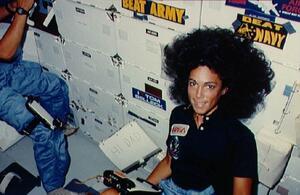Judith Resnik becomes first Jewish American astronaut and second woman in space
Courtesy of NASA, Kennedy Space Center.
The daughter of Jewish immigrants from Ukraine, Judith Resnik grew up in Akron, Ohio. Attending Firestone High School, she was the only female student at the school to achieve a perfect score on her SAT examinations. Excelling in mathematics from an early age, she went to Carnegie Mellon University in Pittsburgh, receiving a BS in electrical engineering in 1970 and a doctorate in electrical engineering from the University of Maryland in 1977.
While working on her graduate degree, she was employed by RCA in Moorestown, New Jersey and Springfield, Virginia. Her design engineer work with RCA included designing custom integrated circuitry for radar control systems, project management of control system equipment, and her first work for the National Aeronautics and Space Administration (NASA), support for the sounding rocket and telemetry systems programs.
She joined the Laboratory of Neurophysiology at the National Institutes of Health (NIH) in Bethesda, Maryland as a biomedical engineer and staff fellow, where she performed biological research on the physiology of visual systems. But it was an encounter with the actress Nichelle Nichols (Lt. Uhura on Star Trek, a NASA recruiter, and an advocate for women and minorities in the scientific fields) that encouraged Resnik to apply to become a NASA astronaut. Of the 8,000 applicants, NASA accepted just 35, six of them women, including Resnik.
Excelling in her year-long training, Resnik began her work on the Remote Manipulator System (RMS), operating the huge arm of orbiter spacecraft. It was this work that made her a prime candidate for the crew of the maiden flight of the orbiter Discovery. For seven days, Resnik operated experiments in crystal growth and photography suing the IMAX motion picture camera. She also displayed her acrobatic skills in weightlessness for viewers of the Discovery’s video transmissions, and held up a sign that said, “Hi Dad.” But it was Resnik’s skill in manipulating the RMS system to remove dangerous ice crystals from the orbiter that earned the crew the nickname “Icebusters.” By the end of the flight, Resnik had logged nearly 145 hours in space.
Killed in the explosion of the orbiter Challenger on January 28, 1986, Resnik was given many posthumous honors, including the IEEE Judith A. Resnik Award, established by the Institute of Electrical and Electronics Engineers and awarded to an individual or team in recognition of outstanding contributions to space engineering.
In a speech at the Akron Roundtable in 1984, Resnik advised students to “Study what interests you. Do all you can and don’t be afraid to expand into new fields.”
Sources: “Judith A Resnik,” NASA; “Judith Resnik,” Akron Women’s History.




thank you so much for this it was vary helpful